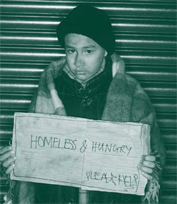July/August 2008
In this Issue
Toward Understanding Homelessness
Homelessness: A National Perspective
Calculating the True Cost of Housing
A Focus on Fair Housing
In the next issue of ResearchWorks
Homelessness: A National Perspective
Efforts to alleviate homelessness must necessarily begin with reliable data on homeless people. Since 2001, Congress has issued a series of directives asking HUD to assist local communities in setting up Homeless Management Information Systems (HMIS) and putting client-level reporting in place. The goal is to develop an unduplicated count of homeless people and an assessment of homeless assistance services. After two years spent developing information systems in 58 sample sites and gathering information from 16 additional contributing communities, a national picture of homelessness is beginning to emerge.
What We're Learning
On one day in January 2006, a concerted nationwide effort to stage a point-in-time count of the homeless resulted in an estimate of 759,101 homeless people in America. About 44 percent were without shelter, living on the street, on steam grates, in parks, in abandoned buildings, and in other places not meant for human habitation. Fifty-six percent of those identified in this count were in shelters — emergency, transitional, or permanent supportive housing. Children accompanied just under half of these sheltered individuals.
According to this count, about 21 percent of the total homeless population consisted of the chronically homeless, defined as unaccompanied individuals with a disability who have either been continuously homeless for at least a year or had at least four episodes of homelessness in the past three years.
Offering a more complete picture than a point-in-time count, HMIS data collected by participating local communities between January and June 2006 documented the use of emergency shelters and transitional housing by 1.15 million homeless people. The six months of collected data yielded the following key findings:
- Children represent a significant proportion of the homeless population; indeed, 27 percent of all homeless persons were members of households with children. Children made up roughly 20 percent of those using shelters.
- More than half (53 percent) of those using homeless shelters were single adult males, although this population segment constitutes only 23 percent of the U.S. population.
- Minorities were disproportionately represented among the sheltered homeless. Although representing a third of the general population, minorities accounted for about two-thirds of the sheltered homeless population — a segment in which African Americans were heavily overrepresented.
- Veterans accounted for 14 percent of the sheltered homeless population.
- Sheltered homeless adults were more than twice as likely as the overall U.S. population to have a disability.
- Three out of four sheltered homeless people were in central cities, rather than suburban or rural areas.
There are approximately 603,212 year-round beds for the homeless, distributed evenly across emergency, transitional, and permanent supportive housing. An additional 76,816 seasonal, overflow, and voucher beds add to the nation’s total capacity. Whether this bed inventory is sufficient for meeting the need depends on a number of variables, including the location of beds, length of stay, and family or household composition. For example, bed utilization rates are affected by conditions such as families occupying a housing unit with more than the needed number of beds, or by designating program slots for a particular client group (e.g., veterans or women recovering from substance abuse).
These and many more data are reported in HUD's recently published Second Annual Homeless Assessment Report to Congress, which provides a national perspective on homelessness. Subsequent assessments will cover an increasing number of communities and providers for a longer time span. Accrued data and an expanded information base will detail patterns of service use and needs of the homeless, moving the nation closer to the ultimate goal of eliminating homelessness.
HUD's Second Annual Homeless Assessment Report to Congress can be downloaded at no cost at www.hudhre.info/documents/2ndHomelessAssessmentReport.pdf.
 HUD's Homelessness Resource Exchange (HRE) is an electronic source of both HUD-sponsored and outside information on homelessness. HRE users will find program guidance and regulations, technical assistance and training resources, as well as research and publications. The data provided is of interest to federal agencies, state and local government agencies, organizations involved in fighting homelessness, and near-homeless or homeless individuals. Resources available through HUD's HRE (www.hudhre.info) include information on homeless prevention, accessing housing and services, project development, grant administration, program measurement and design, and homeless subpopulations. One example of the resources available from the HRE is a set of guides for collecting data about the sheltered and unsheltered homeless. The HRE also offers a map to help homeless providers find their local technical assistance organizations, a newsletter (e*SNAPS), and regular updates on homelessness and available resources.
HUD's Homelessness Resource Exchange (HRE) is an electronic source of both HUD-sponsored and outside information on homelessness. HRE users will find program guidance and regulations, technical assistance and training resources, as well as research and publications. The data provided is of interest to federal agencies, state and local government agencies, organizations involved in fighting homelessness, and near-homeless or homeless individuals. Resources available through HUD's HRE (www.hudhre.info) include information on homeless prevention, accessing housing and services, project development, grant administration, program measurement and design, and homeless subpopulations. One example of the resources available from the HRE is a set of guides for collecting data about the sheltered and unsheltered homeless. The HRE also offers a map to help homeless providers find their local technical assistance organizations, a newsletter (e*SNAPS), and regular updates on homelessness and available resources. |

